Foundry & industrial processing Machinery EQUIPMENT & SYSTEMS
U.S. & Canada Call 1.800.457.5456
GREEN SAND TO NO-BAKE CONVERSION AT AMERICAN FOUNDRY GROUP
Home Articles GREEN SAND TO NO-BAKE CONVERSION AT AMERICAN FOUNDRY GROUP
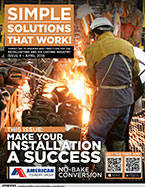
Simple Solutions That Work!™, Volume 4, April 2016
Written - Jack Palmer
Jack Palmer
President
Palmer Manufacturing & Supply, Inc.
Article Takeaways:

American Foundry Group (AFG) is a consortium of foundries in Muskogee, Oklahoma and Bixby, Oklahoma producing steel castings in the broadest range of sizes – from ounces to tons. They are a full service foundry that has a wide range of molding capabilities and production capacities as well. The management at AFG was concerned with the Bixby facility, a 100% green sand foundry as:
- labor costs per ton were high and rising
- quality was acceptable but required a great deal of cleaning room time
- working and environmental conditions needed to improve
- profitability wasn’t acceptablde
- delivery times were increasing
Current State
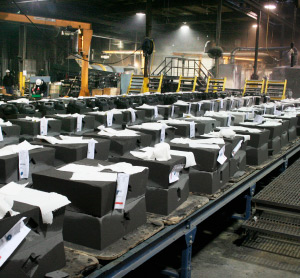
Most of the castings made are fairly simple with only a few cores. Production quantities range from 1-100 castings on average orders, with orders of less than 10 castings per order being very common.
Molding was accomplished with a number of overhead stations with snap flask molding and cope/drag floor molding up to approximately 36 x 36.
The majority of their green sand equipment was showing its age and therefore was requiring an abnormal level of maintenance.
This facility, with the exception of induction melting and chemically bonded sand cores, would be familiar to foundry people from 30-40 years ago. This facility was an essential part of the group’s offerings in size and quantities and therefore, it was critical that the facility be modernized.
Obviously the most logical path would be to upgrade the sand plant and go to some form of automated green sand molding – this was fully explored, and rough budget numbers determined as best as possible.
While it was a simple matter to buy a new mullor to improve green sand distribution and storage; the problem of low average order quantities and hundreds if not thousands of legacy patterns remained. It was not uncommon to have 40 to 50 pattern changes per day in a multitude of sizes from 12 x 12 4/4 to 24 x 24 10/10.
This is not a situation that lends itself to any automatic green sand molding machine without exten- sive and costly changes or com- plete replacement of patterns.
We all know that customers are almost universally reluctant to absorb any cost to replace or change patterns and with even a simple wooden matchplate poten- tially costing $1500 to replace – this wasn’t an available option.
Given their extensive experience in chemically bonded systems (CBS) at the Muskogee plant, a team was assembled to research the possibil- ity of changing this plant from 100% green sand to 100% CBS production.
Evaluation
The main criteria to evaluate were:
- Overall installed cost vs alternatives
- Production capabilities / existing pattern change capabilities/ small quantity – small order flexibility
- Staffing
- Installation downtim
- Safety and environmental requirements
- Floor space requirement
- Training requirement
As with any installation project, but especially with a project that fun- damentally changed the overall production foundation of this facility, there were dozens if not hundreds of items to consider.
The current backlog was high and rising at the time and floor space was limited. This meant making removal of old equipment and installation of new equipment had to be very effi- cient in order to to ensure they could get back up and running quickly.
After thorough review of available equipment and systems, a univer - sal molding machine was selected to be the heart of this no-bake molding operation. A universal molding machine (UMM) would be able to replicate small runs of simple to complex casings, all on one machine. It would be able to use existing green sand tooling, which of course is a huge cost saving benefit.
The carousel-based universal molding machine series takes existing green sand patterns, adds simple inexpensive wood or metal boxes to them, and mounts these assemblies to the machine using a simple, very flexible pattern change design that allows for pattern changes in less than 60 seconds.
This model was ideal for this instal- lation for a number of reasons:
- Very reasonable footprin
- The number of stations allows for ample setup time for the PUNB (phenolic urethane no bake) system while allowing for a high number of "rounds" per day which gives higher potential quantities of a given part in 1 day vs a carousel with more stations or a traditional conveyor based molding loop with transfer cars
- Quick installation time
- Very low training requirements vs green sand molding systems
- Much lower cost and lower floor space requirement than any type of automated or semi – automated green sand system with comparable size and production capabilities
Additional Requirements
The system was initially designed for a production rate of 40 molds per hour in sizes up to 24 x 24 10/10.
Given these production rates and the need for exact work/strip times, a new sand storage, heating and mixing system was included in the project.
Temperature also needed to be controlled within 2-3 degrees F and chemical / catalyst additions needed to be plus or minus .5%
Sand Reclamation
The sand reclamation system needed to be installed before or concurrently with the UMM system. Thermal reclamation was not determined to be essential to the first phase, but was added in phase 2 a few years later.
Sequencing Equipment Installation
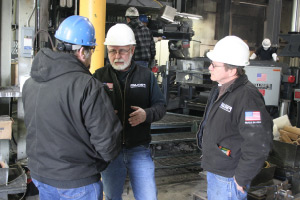
Sequencing of installation was important as production interrup- tions were unacceptable.
Fortunately the outside location of the main storage silos allowed the foundations to be poured and cured before loading
The UMM was constructed in kit form with a standalone struc - tural framework that held both sand heaters and the mixer. All wiring and plumbing was included as far as possible during con- struction/assembly testing at the manufacturer.
Once the delivery date for the molding equipment and downstream mold handling and reclamation equipment was established, a very tight removal / installation time of 6 weeks was established.
Basic installation Phases
- Site preparation – included as much concrete work as far ahead as possible to allow for reasonable curing times before loading / installation of all services ( power / air / gas / water / communication).
- Existing equipment removal – was fairly straightforward as the value of the existing green sand equipment was low and did not warrant careful removal.
- Concurrent installation of equipment – new heater, mixer framework, mold assembly, handling, cooling, and shakeout reclamation was required to get the new system up and running quickly.
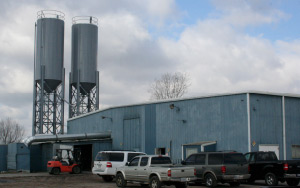
The UMM system uses existing matchplate or cope/drag pat- terns. This means that in general, one mold half is resident on the machine until the second half is made resulting in the elimina- tion of the biggest drawback of using green sand match plates in no-bake molding– keeping copes and drags together. In operation, all 6 copes are made and stay on the machine. As the drags are produced and extracted from the UMM, the copes follow right after. This results production process with no molds being made for 6 indexes of the machine and then 6 molds coming out in a row for the next 6 indexes.
There is a small segmented 6 station carousel adjacent to the UMM with each segment being dedicated to the corresponding station on the UMM. All rods/ cores/chills/ram-up cores are placed on the correct station and rotated in conjunction with the UMM. Normally a “rider” is included with the segment. This is a simple document listing quanti- ties, alloy, etc., that goes with the mold as it is produced / assembled and poured.
These parts are staged in the area in close proximity to this carousel. This same area is used for pattern staging and changing with pat- terns staged as far ahead as nec - essary to allow a complete shift to be run without any delays. AFG worked with their internal tooling engineers and local pattern shops to design a very simple, inex - pensive, and efficient method of mounting boxes to patterns.
Steel boxes were chosen for this installation since the boxes could be constructed to much more exacting tolerances than wood. 5 sizes of boxes with 3 different heights were produced for stan- dardization purposes
Installation Results
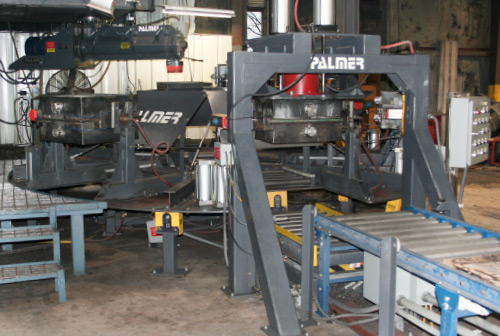
Due to the sequencing and staging of the phases, this installation went very close to the timeline and therefore there were no installa- tion ‘surprises’ due to the exten- sive planning.
Key benefits included:
- Staffing reduction
- Installation timeline – was held
- Training was minima
- Castings appearance is much better
- Quality was enhanced and the cleaning room was no longer the bottleneck
- WIP was reduced by 85% – freeing up a substantial amount of capital
- They are shipping 5% less metal for a given casting due to the elimination of green sand swell
- Backlog was greatly reduce
- Deliveries were being made in a few days instead of weeks previously
- Equipment maintenance was reduced by approximately 90%
- Profitability increased due to increased production and much lower costs
- Working conditions were greatly improved due to reduced dust
The big ‘surprise’ came in exceed- ing the required production rate by over 50% to a rate of 60+ molds per hour, which more than jus- tified the cost of equipment and installation. To date, this system has achieved rates as high as 65 mold per hour even with 30 or more pattern changes per shift.
The success of any installation is normally financially expressed in ROI. Once the system was up and running the analysis determined that ROI was less than 10 months! AFG management is actively reviewing their other facilities to determine how to best apply the success of this project, to their other facilities.
This particular model is a PMS 6/30/12:
- 6 station
- Capable of 30 x 30
- Capable of 12 over 12 cope and drag
- Production rates of up to 65 MPH
Copyright © 2025 Palmer Manufacturing & Supply, Inc. | Terms and Conditions | Privacy Policy




